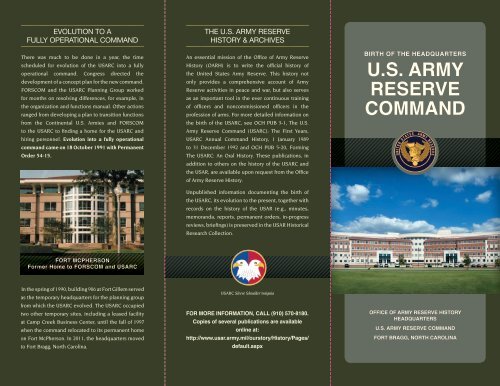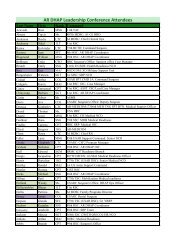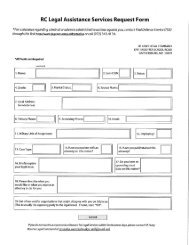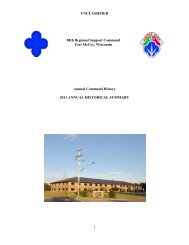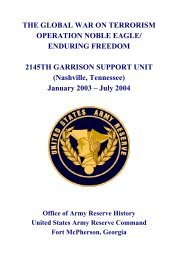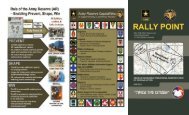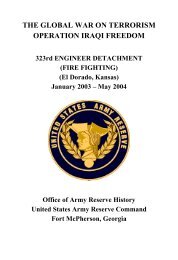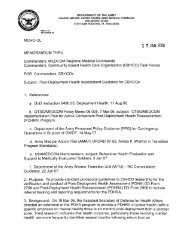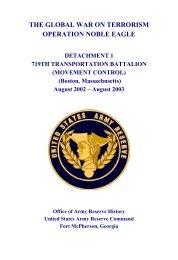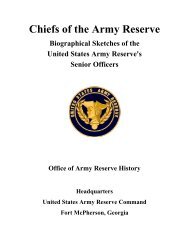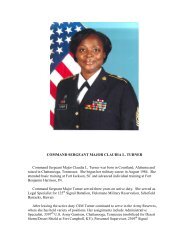U.S. ARMY RESERVE COMMAND
U.S. ARMY RESERVE COMMAND
U.S. ARMY RESERVE COMMAND
You also want an ePaper? Increase the reach of your titles
YUMPU automatically turns print PDFs into web optimized ePapers that Google loves.
EVOLUTION TO A<br />
FULLY OPERATIONAL <strong>COMMAND</strong><br />
There was much to be done in a year, the time<br />
scheduled for evolution of the USARC into a fully<br />
operational command. Congress directed the<br />
development of a concept plan for the new command.<br />
FORSCOM and the USARC Planning Group worked<br />
for months on resolving differences, for example, in<br />
the organization and functions manual. Other actions<br />
ranged from developing a plan to transition functions<br />
from the Continental U.S. Armies and FORSCOM<br />
to the USARC to finding a home for the USARC and<br />
hiring personnel. Evolution into a fully operational<br />
command came on 18 October 1991 with Permanent<br />
Order 54-15.<br />
THE U.S. <strong>ARMY</strong> <strong>RESERVE</strong><br />
HISTORY & ARCHIVES<br />
An essential mission of the Office of Army Reserve<br />
History (OARH) is to write the official history of<br />
the United States Army Reserve. This history not<br />
only provides a comprehensive account of Army<br />
Reserve activities in peace and war, but also serves<br />
as an important tool in the ever continuous training<br />
of officers and noncommissioned officers in the<br />
profession of arms. For more detailed information on<br />
the birth of the USARC, see OCH PUB 3-1, The U.S.<br />
Army Reserve Command (USARC): The First Years,<br />
USARC Annual Command History, 1 January 1989<br />
to 31 December 1992 and OCH PUB 5-20, Forming<br />
The USARC: An Oral History. These publications, in<br />
addition to others on the history of the USARC and<br />
the USAR, are available upon request from the Office<br />
of Army Reserve History.<br />
Unpublished information documenting the birth of<br />
the USARC, its evolution to the present, together with<br />
records on the history of the USAR (e.g., minutes,<br />
memoranda, reports, permanent orders, in-progress<br />
reviews, briefings) is preserved in the USAR Historical<br />
Research Collection.<br />
BIRTH OF THE HEADQUARTERS<br />
U.S. <strong>ARMY</strong><br />
<strong>RESERVE</strong><br />
<strong>COMMAND</strong><br />
FORT MCPHERSON<br />
Former Home to FORSCOM and USARC<br />
In the spring of 1990, building 906 at Fort Gillem served<br />
as the temporary headquarters for the planning group<br />
from which the USARC evolved. The USARC occupied<br />
two other temporary sites, including a leased facility<br />
at Camp Creek Business Center, until the fall of 1997<br />
when the command relocated to its permanent home<br />
on Fort McPherson. In 2011, the headquarters moved<br />
to Fort Bragg, North Carolina.<br />
USARC Sleeve Shoulder Insignia<br />
FOR MORE INFORMATION, CALL (910) 570-8180.<br />
Copies of several publications are available<br />
online at:<br />
http://www.usar.army.mil/ourstory/History/Pages/<br />
default.aspx<br />
OFFICE OF <strong>ARMY</strong> <strong>RESERVE</strong> HISTORY<br />
HEADQUARTERS<br />
U.S. <strong>ARMY</strong> <strong>RESERVE</strong> <strong>COMMAND</strong><br />
FORT BRAGG, NORTH CAROLINA
I<br />
Z<br />
THE CITIZEN SOLDIER CONCEPT<br />
The history of America’s federal citizen soldier extends<br />
back in time to the early years of the Republic. In fact, one<br />
of our founding fathers, leader of the Continental Army,<br />
and first president, George Washington, presented his<br />
concept for a federalized militia in 1783 to a congressional<br />
committee created under Alexander Hamilton to<br />
investigate and recommend a military establishment.<br />
This was the first of a multitude of congressional<br />
committees formed to study and investigate the issue of<br />
a national militia.<br />
THE EARLY <strong>RESERVE</strong> CORPS<br />
That debate gradually evolved into action by Congress<br />
on 23 April 1908 to officially establish a federal reserve,<br />
the Medical Reserve Corps, followed by the National<br />
Defense Acts of 1916 and 1920 creating the Officers’<br />
Reserve Corps and the Enlisted Reserve Corps, renamed<br />
the Organized Reserve Corps. Between 1952 and 1955<br />
legislation ordered the redesignation of the Organized<br />
Reserve Corps as the Army Reserve.<br />
ESTABLISHMENT OF THE CHIEF,<br />
<strong>ARMY</strong> <strong>RESERVE</strong><br />
As the evolutionary process continued, there were more<br />
congressional hearings and investigations and major<br />
reorganizations of the Army, including Secretary of<br />
Defense Robert S. McNamara’s failed attempt between<br />
1965 and 1966 to merge units of the Army Reserve into<br />
the Army National Guard. In 1967 Congress passed<br />
watershed legislation in the form of the Reserve Forces<br />
Bill of Rights and Vitalization Act. In essence that act,<br />
among other features, prescribed reserve leadership for<br />
reserve units. For the Army, the act created a statutory<br />
Chief, Army Reserve (CAR) who served as an advisor to<br />
the Chief of Staff on Army Reserve matters. Command<br />
and control of the Army Reserve, however, was under<br />
Continental Army Command (CONARC) until 1973<br />
and after that under Forces Command (FORSCOM).<br />
The act also virtually eliminated bitter congressional<br />
deliberation over reserve component policy--for a while.<br />
T W<br />
C<br />
E<br />
T<br />
H<br />
CONGRESS DIRECTS DESIGN OF A<br />
<strong>COMMAND</strong> AND CONTROL PLAN<br />
In 1988, the House Committee on Appropriations Surveys<br />
and Investigation rekindled the debate. The committee<br />
uncovered two command and control reporting chains<br />
for the Army Reserve: FORSCOM and the CAR. Unlike<br />
the Air Force Reserve and the Navy Reserve, the CAR<br />
did not have sole command of the Army Reserve. In 1989<br />
Congress directed the Army to design a command and<br />
control plan for the Army Reserve. Congress and the<br />
Army, with FORSCOM in the lead, began the struggle,<br />
at times difficult, to produce a mutually agreeable<br />
arrangement for the Army Reserve.<br />
FORSCOM, the Office of the Chief Army Reserve (OCAR),<br />
the Department of the Army, and Congress each had its<br />
own plan. Command and control options spanned from<br />
the creation of an independent major command to a<br />
major subordinate command under FORSCOM.<br />
MAJOR SUBORDINATE <strong>COMMAND</strong><br />
STATUS<br />
On 18 January 1990, the CAR and the FORSCOM<br />
commander reached an agreement, a major step in the<br />
evolution of the new command. The Army’s plan called<br />
for the command to be organized as a major subordinate<br />
command. FORSCOM was to develop overall policy for<br />
units of the U.S. Army Reserve (USAR), while the Reserve<br />
Command was to prepare implementation procedures,<br />
plans, and programs in accordance with FORSCOM<br />
guidance. Integration of the active component and<br />
reserve component into a total force was the ultimate<br />
objective.<br />
E<br />
N<br />
E<br />
C<br />
I<br />
T<br />
I<br />
U.S. <strong>ARMY</strong> <strong>RESERVE</strong> <strong>COMMAND</strong><br />
PLANNING GROUP<br />
As the plans were staffed and reviewed, FORSCOM<br />
pushed forward in March 1990 by creating the U.S. Army<br />
Reserve Command (USARC) Planning Group charged<br />
with providing the functional nucleus to plan and<br />
develop the details for establishing the USARC (e.g.,<br />
table of distribution and allowance, organization and<br />
functions manual, etc.). The USARC Planning Group was<br />
to evolve into the heart of the new USARC headquarters.<br />
Meanwhile, Congress and the Army had differing views<br />
on the next course of action. In the midst of this came<br />
another negotiated agreement between the OCAR and<br />
FORSCOM, the management of USAR funds.<br />
U.S. <strong>ARMY</strong> <strong>RESERVE</strong> <strong>COMMAND</strong><br />
(PROVISIONAL)<br />
Permanent Order 183-13 dated 1 October 1990<br />
established the U.S. Army Reserve Command<br />
(Provisional). Congress legally formalized this<br />
arrangement in November 1990 with passage of the<br />
National Defense Authorization Act for Fiscal Year<br />
1991. The act assigned to the command all Army<br />
Reserve forces in the continental United States, save<br />
those assigned to Special Operations Forces and those<br />
forces as directed by the Secretary of Defense. The<br />
act set a test period of two years for operation of the<br />
command and required the Secretary of the Army during<br />
the test period to submit semiannual reports on the<br />
command to the Committee on Armed Services of both<br />
congressional houses. The act directed the Secretary<br />
of the Army to establish an independent commission<br />
assisting the Secretary of the Army in evaluating the<br />
progress and effectiveness of the command. Twentythree<br />
years after passage of the Reserve Forces Bill of<br />
Rights and Vitalization Act, the CAR was in statutory<br />
command of the Army Reserve.


